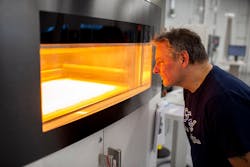The Defense Production Act (DPA), a law established in 1950 in response to the start of the Korean War, grants the executive branch power to direct the U.S. industrial segments to prioritize the production of goods in scant supply. DPA was invoked by President Trump on March 18th in the event it was needed to attain more medical equipment to aid in the war against the Coronavirus disease 2019 (COVID-19). But it has not yet been fully enforced.
Automakers are well-aware that they may be told to convert manufacturing lines to make critical medical equipment. In a preemptive move, Ford Motor Company announced this morning that it will do just that, but in a very targeted way.
Four days ago, the car manufacturer joined forces with GE Healthcare and 3M to expand the production of medical equipment—including ventilators and respirators—for healthcare workers, first responders, and patients fighting COVID-19. In addition, Ford plans to assemble more than 100,000 face shields per week and leverage its in-house 3D printing capability to produce components for use in personal protective equipment (PPE).
On a news conference call this morning with the media, Ford, 3M, and GE Healthcare officials outlined details of the partnerships, which internally is dubbed “project Apollo,” a reference to the Apollo 13 space mission known for a malfunction in an oxygen tank that required the crew to invent a quick fix to stabilize the spacecraft and return to Earth.
“There is a critical need now and it is evolving as we understand how the virus might enter the body,” said Jim Baumbick, vice president, enterprise product line management for Ford. “Given the wave of cases, we want to have a level of protection for the first responders and volunteers. They all inspired us to get scrappy.”
Reengineering Fans and Filters
Ford is working with 3M to scale the production of its Powered Air-Purifying Respirators (PAPRs), lending its engineering expertise to create new designs that leverage off-the-shelf parts like fans from the Ford F-150’s cooled seats for airflow, 3M HEPA air filters to filter airborne contaminants such as droplets that carry virus particles, and portable tool battery packs to power these respirators for up to eight hours.
“We are focused on trying to increase throughput and the capability of 3M’s existing design, and in parallel, we’ll [develop] a simplified design using parts we have available,” Baumbick said. “There will be commonality between designs so the consumables attached can be interchangeable between units. The goal is to increase quickly the amount of volume given the demand in the short run. Time here is the enemy, we have to move quickly.”
Mike Kesti, global technical director for the 3M Personal Safety Division, echoed that, noting the team is trying to be resourceful, agile, and creative about how to make it all work and build capacity, including how to extend the control system and get regulatory approval to modify designs or for a different manufacturing footprint. “We are working on those strategies.”
Ford is also working with GE Healthcare to expand production of a simplified version of the company’s existing ventilator design to support patients with respiratory failure or difficulty breathing. These ventilators could be produced at a Ford manufacturing site in addition to a GE location. Currently, however, there is no timeline or exact number for the release of the new GE Healthcare ventilators or the 3M respirators, but they are working to increase capacity over the next few days and weeks and are working closely with the FEMA and government officials for quick distribution to the right areas, they said.
Retooling the Factory Floor
Also at a Ford manufacturing site, in cooperation with the United Auto Workers (UAW), the company’s U.S. design team is quickly creating and starting to test transparent full-face shields for medical workers and first responders. The face shields fully block the face and eyes from accidental contact with liquids and when paired with N95 respirators can be a more effective way to limit potential exposure to Coronavirus than N95 respirators alone.
The first 1,000 face shields will be tested this week at Detroit Mercy, Henry Ford Health Systems, and Detroit Medical Center Sinai-Grace Hospitals. Roughly 75,000 of these shields are expected to be finished this week and more than 100,000 face shields per week will be produced at Ford subsidiary Troy Design and Manufacturing’s facilities in Plymouth, Mich.
Ford is also leveraging its Advanced Manufacturing Center in Redford, Mich., and in-house 3D printing capabilities to manufacture components and subassemblies for use in personal protective equipment. The 3D printers, however, will be used for prototyping and exploring new designs rather than scaling production.
Overall, this partnership is a great example of how manufacturers will need to be flexible in the near term—which could set them up for new opportunities in the future.
“We are preparing a range of options in terms of facilities we could leverage to increase throughput and scale if we need to, but the immediate focus is to leverage what GE and 3M have and expand their capacity,” Ford’s Baumbick said. “We’ll be bringing our manufacturing expertise and design support to those teams to break constraints and open up potential new supply channels, and in some cases deploy additional skilled labor.”
For more coverage of COVID-19 in manufacturing:
GE Digital Responds to COVID-19 Concerns
Leaders relevant to this article:

